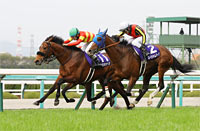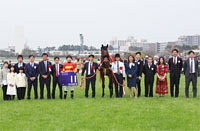Osaka Hai (G1) - Data Analysis
Race that determines the spring turf middle-distance champion from among top talents
The 2021 Osaka Hai was won by Lei Papale, who led the pack throughout the race to secure a victory in her first G1 race. Third-place finisher Contrail went on to dominate the Japan Cup of the same year, while fourth-place finisher Gran Alegria subsequently triumphed in the Victoria Mile and the Mile Championship of the same year. In addition, 2020 winner Lucky Lilac won the Queen Elizabeth II Cup of the same year, and runner-up Chrono Genesis dominated the Takarazuka Kinen and Arima Kinen (The Grand Prix) of the same year. In other words, the Osaka Hai attract top runners that also perform well in subsequent G1 races. Let's now analyze some features shared by successful runners in this race based on results over the last 10 years, during which the Osaka Hai was held as a G2 race (until 2016) and as a G1 race (from 2017).
Younger horses have the edge
Of the 30 Top 3 finishers in the last 10 years, 25 were aged 5 or below. Conversely, horses aged 6 or above struggled with a Top 3 ratio of 9.6%. In other words, we should lower our expectations of horses aged 6 and above. [Table 1]
[Table 1] Performance by age (last 10 years)
| Year |
Performance
[1st-2nd-3rd-4th or lower] |
Win ratio |
Top 2 ratio |
Top 3 ratio |
| 5 or below |
10-8-7-51 |
13.2% |
23.7% |
32.9% |
| 6 or above |
0-2-3-47 |
0% |
3.8% |
9.6% |
Performance in G1 races since previous year is a key factor
Of the 30 Top 3 finishers in the last 10 years, 24 had experience of finishing in the Top 4 of a JRA G1 race since the previous year. In contrast, runners without such experience struggled with a Top 3 ratio of 8.5%. This suggests we should focus on runners with experience of finishing in the Top 4 of major races since the previous year. [Table 2]
[Table 2] Performance by experience of finishing in the Top 4 of a JRA G1 race since the previous year (last 10 years)
| Experience |
Performance
[1st-2nd-3rd-4th or lower] |
Win ratio |
Top 2 ratio |
Top 3 ratio |
| Yes |
7-8-9-33 |
12.3% |
26.3% |
42.1% |
| No |
3-2-1-65 |
4.2% |
7.0% |
8.5% |
In addition, among runners without experience of finishing in the Top 4 of a JRA G1 race since the previous year, horses aged 5 and above struggled even more with a Top 3 ratio of 5.1%. Such runners are therefore unlikely to chase the top places. [Table 3]
[Table 3] Among runners without experience of finishing in the Top 4 of a JRA G1 race since the previous year, performance by age (last 10 years)
| Age |
Performance
[1st-2nd-3rd-4th or lower] |
Win ratio |
Top 2 ratio |
Top 3 ratio |
| 4 |
3-0-0-9 |
25.0% |
25.0% |
25.0% |
| 5 or above |
0-2-1-56 |
0% |
3.4% |
5.1% |
Miho-trained horses fare poorly
Of the 30 Top 3 finishers in the last 10 years, 28 were Ritto-trained runners. Conversely, Miho-trained runners struggled with a Top 3 ratio of 6.7%, even though 12 of the 30 such runners were backed as 3rd favorite or higher. In other words, we should lower our expectations of Miho-trained horses. [Table 4]
[Table 4] Performance by affiliation (last 10 years)
| Affiliation |
Performance
[1st-2nd-3rd-4th or lower] |
Win ratio |
Top 2 ratio |
Top 3 ratio |
| Miho |
0-1-1-28 |
0% |
3.3% |
6.7% |
| Ritto |
10-9-9-70 |
10.2% |
19.4% |
28.6% |
Runners that performed well last time out have enjoyed success since the race was upgraded to G1 status
Of the 15 Top 3 finishers in the five years the Osaka Hai has been held as a G1 race, 10 had finished in the Top 2 of their previous race. In contrast, runners that had been beaten to 3rd or lower in their previous race struggled somewhat with a Top 3 ratio of 12.2%. This suggests we should discount runners that have finished outside the Top 2 in their previous race. [Table 5]
[Table 5] Performance by finish in the previous race (last five years)
| Finish in previous race |
Performance
[1st-2nd-3rd-4th or lower] |
Win ratio |
Top 2 ratio |
Top 3 ratio |
| Top 2 |
4-1-5-18 |
14.3% |
17.9% |
35.7% |
| 3rd or lower |
1-4-0-36 |
2.4% |
12.2% |
12.2% |
In addition, among the runners that had finished 3rd or lower in their previous race, the five runners that finished in the Top 3 of the Osaka Hai all had experience of finishing in the Top 3 of "a 2,000-2,200m JRA G1 race since the previous year." We should therefore lower our expectations of runners that have finished 3rd or lower in their previous race and have also finished outside of the Top 3 in G1 races contested over distances close to that of the Osaka Hai since the previous year. [Table 6]
[Table 6] Among runners that had finished 3rd or lower in their previous race, performance by experience of finishing within the Top 3 of "a 2,000-2,200m JRA G1 race since the previous year." (last five years)
Experience |
Performance
[1st-2nd-3rd-4th or lower] |
Win ratio |
Top 2 ratio |
Top 3 ratio |
| Yes |
1-4-0-8 |
7.7% |
38.5% |
38.5% |
| No |
0-0-0-28 |
0% |
0% |
0% |
Record and performance in graded races since the previous year are key factors
The 15 Top 3 finishers in the five years the Osaka Hai has been held as a G1 race all had experience of "ranking 7th or higher when passing the fourth corner and finishing in the Top 2" of a JRA graded race (excluding handicap races) since the previous year. In other words, we should expect lackluster performance from runners that have not achieved a Top 2 finish in a graded race since the previous year, runners that have only achieved a Top 2 finish in a handicap graded race since the previous year, and runners that have finished 2nd in a grade race since the previous year but only ranked 8th or lower when passing the fourth corner in that race. [Table 7]
[Table 7] Performance by experience of "ranking 7th or higher when passing the fourth corner and finishing in the Top 2" of a JRA graded race (excluding handicap races) since the previous year (last five years)
| Experience |
Performance
[1st-2nd-3rd-4th or lower] |
Win ratio |
Top 2 ratio |
Top 3 ratio |
| Yes |
5-5-5-29 |
11.4% |
22.7% |
34.1% |
| No |
0-0-0-25 |
0% |
0% |
0% |
Seek out the winner!
Runners starting in Brackets 1 or 2 have not won in 20 years
All winners in the last 10 years started the race in Brackets 3-8. The last runner to triumph after starting in Brackets 1-2 was Toho Dream in 2001 (Bracket 2). In addition, the last runner aged 6 or above to emerge victorious was T M Encore in 2010 (6 years old at the time), and the last Miho-trained runner to notch the win was Silent Hunter in 1999. In addition to the Bracket number, we should keep in mind the trends shown in Table 1 and Table 4. [Table 8]
[Table 8] Winners' bracket number, age, and affiliation (last 10 years)
| Year |
Winner |
Bracket number |
Age |
Affiliation |
| 2012 |
Shonan Mighty |
8 |
4 |
Ritto |
| 2013 |
Orfevre |
4 |
5 |
Ritto |
| 2014 |
Kizuna |
7 |
4 |
Ritto |
| 2015 |
Lachesis |
3 |
5 |
Ritto |
| 2016 |
Ambitious |
7 |
4 |
Ritto |
| 2017 |
Kitasan Black |
4 |
5 |
Ritto |
| 2018 |
Suave Richard |
8 |
4 |
Ritto |
| 2019 |
Al Ain |
3 |
5 |
Ritto |
| 2020 |
Lucky Lilac |
5 |
5 |
Ritto |
| 2021 |
Lei Papale |
6 |
4 |
Ritto |
(Masaya Ibuki)
|



















